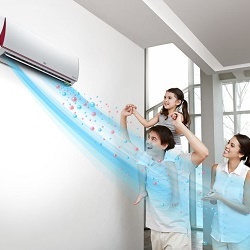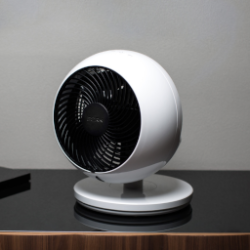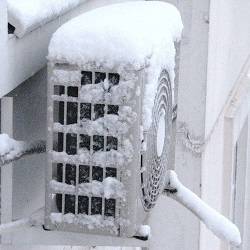Features multi-zone air conditioning systems
Multi-zone air-conditioning system has found its application where even powerful split-systems cannot cope. Unlike household versions, VRF and VRV are centralized air conditioning systems. industrial grade, representing a whole complex of modules. VRF and VRV systems are similar to household or semi-industrial multi-split systems, but in many ways they are superior. They are designed specifically for the maintenance of residential or administrative buildings in several floors.
Content
Short review
Multizone systems are designed for air conditioning in several zones (rooms or rooms) through a single outdoor unit. There are other names: VRF or VRV - the meaning is the same, the difference in abbreviations occurred after the founder of the system patented his invention (VRF).Therefore, all three designations imply the same air-conditioning complex.
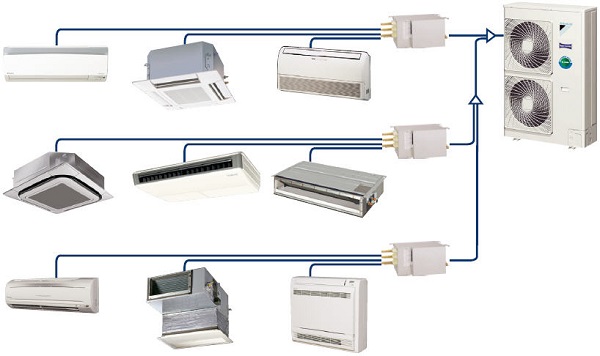
Structurally, the system is a complex of one external and several dozen internal modules, from which the prefix "multi" originates. The peculiarity of VRV / VRF systems allows significantly reduce the number of external modules, which reduces the cost of installation, operation, and also facilitates the design of installation and maintenance of air conditioners.
From a technical point of view, it is much easier to maintain stable operation of one or two external units than twenty, besides, a large number of them on the facade of the building spoils the appearance.
VRV / VRF multisystems are manufactured by various manufacturers - from elite Japanese to budgetary Russian ones. Among the most popular brands are Mitsubishi, Daikin (the author of the VRF system), Sanyo, Ballu and many others, each of them represents the same system with small deviations.
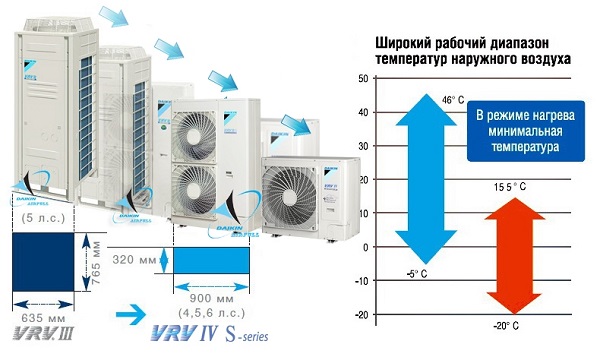
Daikin VRV IV-S RXYSCQ-TV Compact conditioners
Design features of systems
The principle of operation of the complex is reminiscent of a multi-slit system, but it is more productive, more complex scheme.Each VRF / VRV system is built on a block type: the more rooms, the more internal modules. All blocks are combined with each other. freon lineconsisting of several pipes. Collectors or refnets are installed at branch points. The system of two pipes is designed for alternate cooling or heating, and the route of the three pipes will allow to heat and cool the air in different rooms at the same time.
To ensure that the operation of the whole complex does not depend on the reliability of one compressor, it is permissible to install up to three outdoor modules. This makes it possible to use one unit as a backup or to expand the system in the future. The advantage of the design is that after the launch, you can change the air conditioning system, embed additional lines or replace worn areas.
The horizontal length of the route is about 150 m, and the vertical - 50 m, which allows you to organize the air conditioning system on the floor, in the whole building or its separate part.
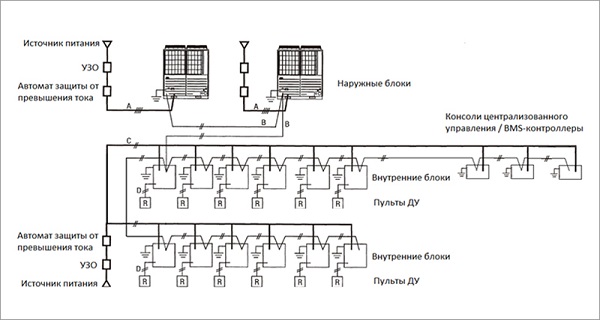
The layout of the multizone system
Control Multizone VRF / VRV is implemented in several ways:
- through a computer using a specialized control program;
- remote control for each internal module;
- from a centralized control panel, which is a panel.
It should be noted that multi-zone air conditioners of different manufacturers may differ, the difference will be in the maximum number of internal modules, the length of the route and the composition of the refrigerant.
Types of blocks
Like the split system, multi-zone air-conditioning systems have two modules: the internal one, installed directly inside the room, and the external one, which is mounted on the street side of the building. As external module most often choose roof modifications. It is more profitable and easier in terms of maintenance: there is no need to resort to the services of climbers, in addition, the design of the facade of the building does not suffer.
Internal module no different from everyday versions:
- cassette;
- wall;
- wall and ceiling;
- channel.
The choice of a suitable unit is not limited and is based on the architecture or design of the room.

Pluses of multizone system
Such air-conditioning complexes acquire banks, office, commercial or administrative buildings.VRF / VRV-systems have many advantages, which compensates for the high cost at the stage of installation and installation.
- Such systems are characterized by flexibility of operation, due to the fact that each internal module is used as needed and can be adjusted.
- Installation of the complex is quite simple, due to the low weight of the internal blocks. For the organization of the air-conditioning system from scratch a few specialists are enough.
- Connected indoor units are presented in various modifications and may differ both in appearance and in performance, models can be chosen in accordance with the characteristics of the premises (archival, residential, office, storage).
- Despite the high cost of installation, VRV / VRF air conditioning systems economical in operation.
- Valves with electronic adjustment provide an accurate dosage of freon, therefore, the set temperature is maintained with an accuracy of +/- 1 °.
- Any modification of air conditioning systems (VRF / VRV) can be combined with the ventilation unit. To do this, the input-extract ventilation (HRV), capable of operating in three modes: full heat exchange, bypass or automatic mode, is connected to the multi-zone complex.
- Integration into the intellectual system of the building is available; on the basis of special software, all modules are monitored, planned and managed. Optimization of operation largely saves energy, eliminating idle work.
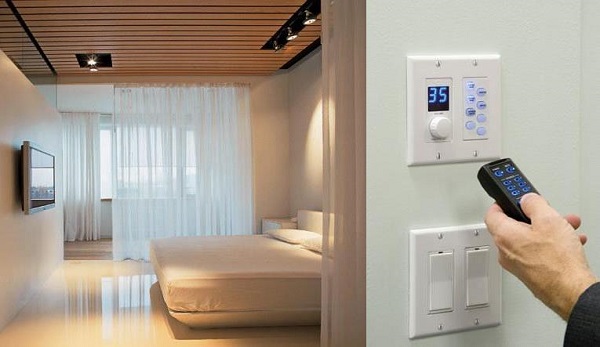
Such indicators will allow the use of multi-zone air conditioners not only for production purposes, but also for air conditioning. in a residential building.
Safety and reliability
If in conventional split systems, if the external side breaks, the entire air conditioning system is paralyzed, then installation of several external modules is permissible in VRF / VRV. When one of them fails, the load is automatically redistributed to the others, maintaining the performance of the entire complex.
The simplicity of the design is beneficial only on one side - the unified pipeline mains supply dozens of internal modules with refrigerant. If the track is damaged, there is a possibility of freon leakage, which paralyzes the entire air conditioning system.. In addition, despite assurances from manufacturers, the refrigerant can be harmful to humans.
Alternative solutions
VRF / VRV multi-zone air conditioners are safer than their competitors, but act as an alternative chiller-fan coil. Despite the external similarity, the chiller is inferior to VRF / VRV in several key points:
- the cost of the chiller is lower, but power consumption is about twice as much, respectively, the operation will cost more;
- requires permanent staff;
- the ability to install pumps, tanks, heat exchangers and other additions are expressed in large labor costs during installation and design;
- no connectivity to HRV.
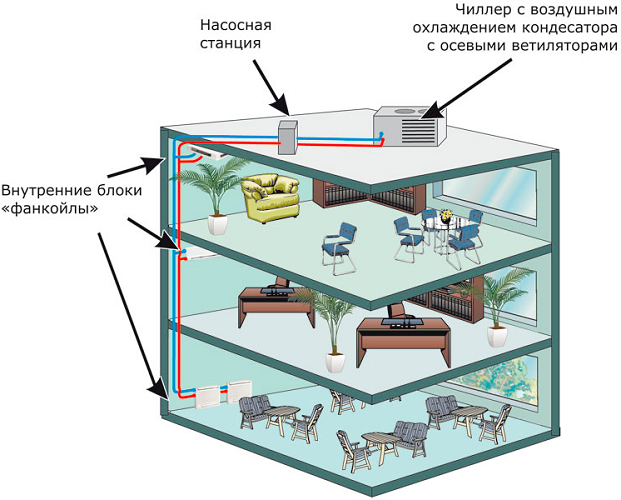
Chiller Fan Coil System
The mode of operation of the clerk is similar to VRF / VRV, control is exercised through centralized panels, remote control panels or via a personal computer. The comparison shows that VRF / VRV is safer and more practical than a celler or multi-split systems.
According to the stated characteristics, multizone systems are quite suitable for installation in a cottage, but in practice this is not rational, because the cost of installation is quite high.
Summing up, we can note the high performance of VRF / VRV-systems, flexibility and reliability of the design, ease of maintenance.Today, they are widely used for air conditioning in office and office buildings, exhibition centers or clubs.

/rating_off.png)






